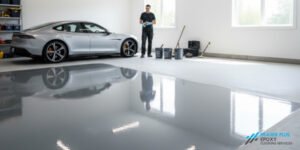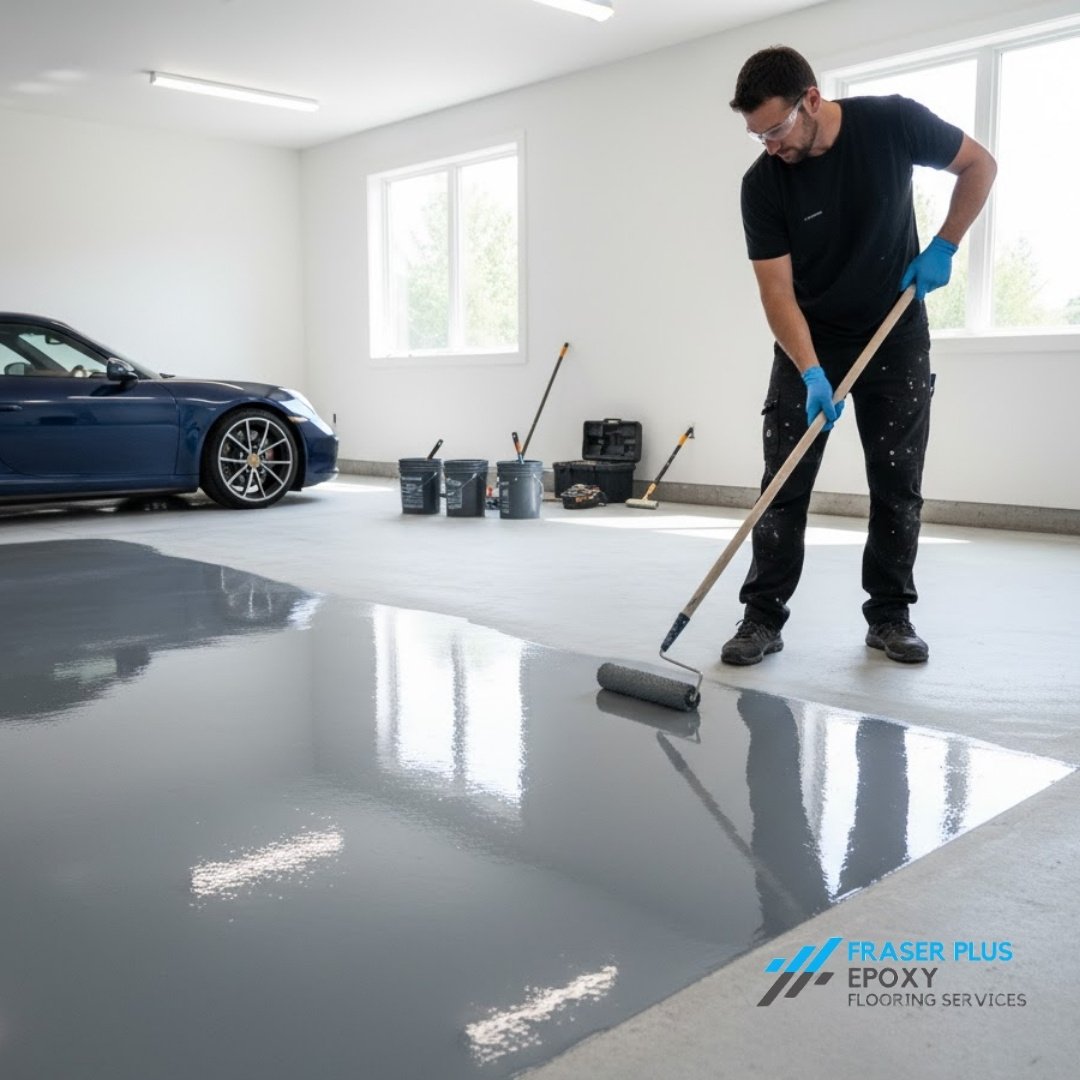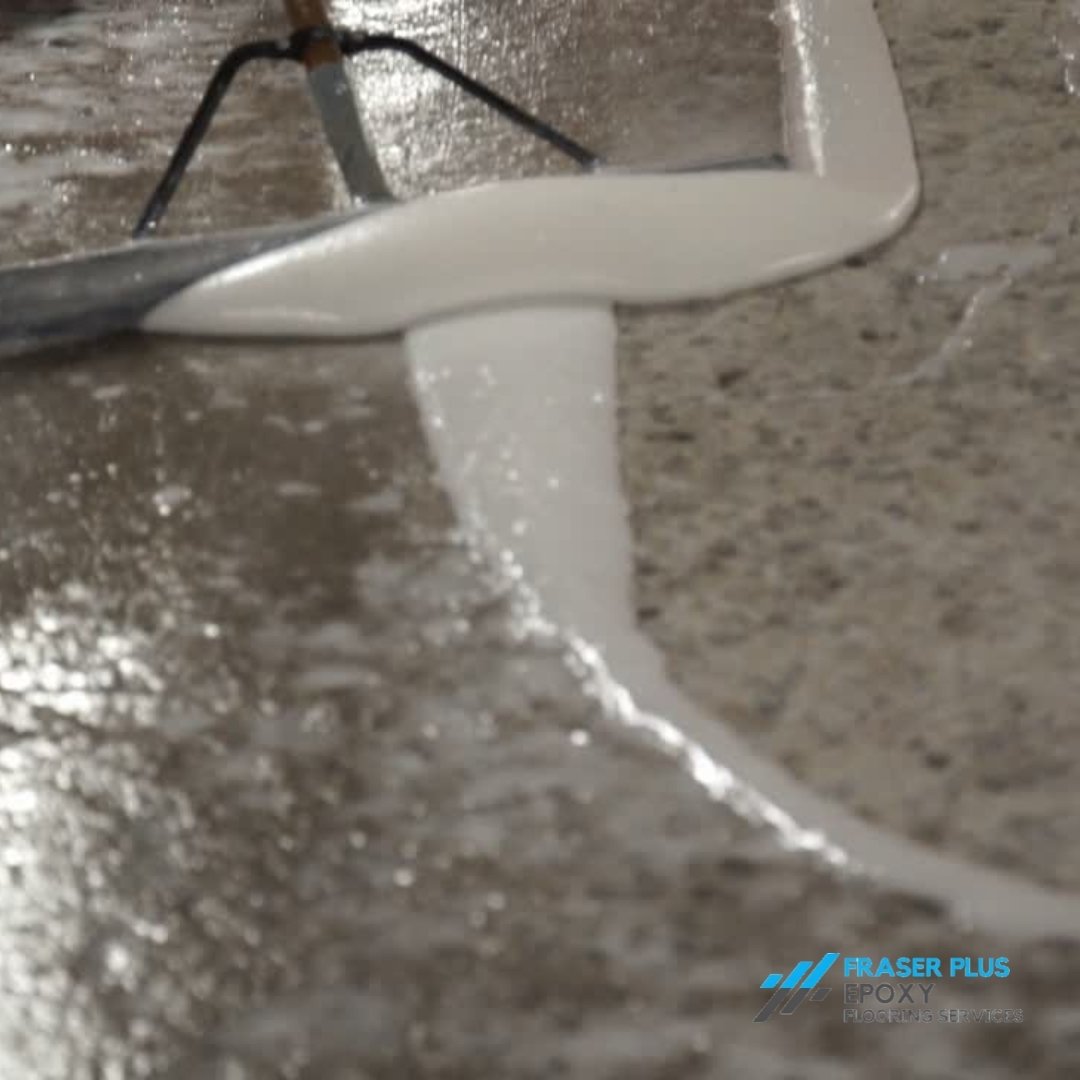The Bubble Trap: Understanding Moisture-Related Failures
Bubbling and blistering are among the most serious early warning signs of epoxy floor failure, yet they’re often mistaken for minor cosmetic flaws that can be left untreated. These bumps in your floor surface are indicators of trapped moisture or vapor pressure beneath your epoxy coating—a problem that will worsen without professional Vancouver epoxy flooring intervention.
In Vancouver’s climate, bubbling typically develops when moisture vapor rises through the concrete substrate and becomes trapped beneath the epoxy coating. This occurs when floors are installed without proper moisture testing or vapor barriers, or when the concrete wasn’t adequately sealed before coating application. The bubbles start small—sometimes just a few millimeters across—but they’re ticking time bombs that expand as moisture pressure increases.
Epoxy Resins for Flooring Applications, an Optimal Host for Various Fillers, published in the scientific journal in the PubMed Central database (PMC), highlights mechanical and thermal properties critical to the long-term performance of epoxy flooring in diverse conditions, making it a valuable reference for understanding epoxy floor durability.
Early-stage bubbling shows as small, fluid-filled bumps that feel soft. Though initially harmless, they indicate bond integrity is compromised. As Vancouver’s seasonal humidity fluctuates, these bubbles expand and contract, creating stress fractures in the epoxy that allow more moisture infiltration.
Advanced bubbling leads to larger blisters often containing visible moisture or appearing cloudy. The epoxy separates from the concrete substrate creating cascading failure patterns. These weak points collect dirt, harbor bacteria, and eventually peel away.
Fraser Plus Epoxy prevents bubbles through comprehensive moisture testing based on ASTM F2170 standards. We measure concrete moisture, assess vapor transmission, and install vapor barriers as needed. This scientific approach eliminates 80% of Vancouver epoxy flooring failures within the first three years.
The Peeling Problem: When Surface Preparation Meets Reality
Peeling and delamination are dramatic epoxy floor failures where entire coating sections lift away from the concrete. These failures rarely happen overnight but result from installation shortcuts or inadequate surface preparation.
Edge peeling begins around room perimeters, doorways, or high-traffic areas. Small sections lift at edges creating tabs. This usually signals inadequate cleaning or grinding during installation. The concrete wasn’t properly profiled for a durable mechanical bond.
Sheet delamination happens when large epoxy pieces peel away, revealing dusty or contaminated concrete underneath. This indicates contaminated concrete, poor surface prep, or incompatibility between epoxy and substrate.
Vancouver’s climate challenges epoxy adhesion because temperature and humidity variations cause constant expansion and contraction of concrete and coating. Poor surface prep shows its flaws over time when thermal stresses cause bond failure.
Fraser Plus Epoxy uses diamond grinding or shot blasting for optimal concrete profiling, complete contamination removal, and thorough moisture testing. We create thousands of microscopic anchor points to multiply bonding surface area and virtually eliminate delamination risks common in DIY or budget installations.
Proper surface preparation costs about 20% more upfront but prevents replacement costs that are 300-500% higher due to premature failure.
Color Changes and Chemical Damage: The Slow Deterioration

Discoloration, yellowing, and chemical etching develop gradually but indicate compromised epoxy protective properties. This leaves concrete vulnerable to permanent damage from spills, stains, and chemicals.
UV-induced yellowing is common in Vancouver garage floors with windows or skylights. Standard epoxy breaks down under UV light, developing a yellow tint that starts subtle but worsens over 12-18 months. Sun-exposed areas show more color change than shaded ones.
Chemical staining and etching appear as permanent discoloration spots from automotive fluids, cleaning agents, or industrial substances. Battery acid, harsh cleaners, and de-icing salts cause whitish or darkened rough spots vulnerable to further damage.
Organic staining results from oil spills, food, or biological materials indicating epoxy seal failure. Properly installed epoxy resists stains, so persistent discoloration signals coating failure or inadequate chemical resistance for your application.
Fraser Plus Epoxy addresses discoloration with advanced coating systems including UV-resistant topcoats for sun-exposed areas and chemical-resistant formulas tailored to each client. We also provide maintenance protocols to preserve floor appearance and protection for years.
Texture Changes: When Protection Becomes Hazard
Surface texture deterioration signals structural problems that can create safety hazards and accelerate damage. Changes in feel, slip resistance, or visual texture require immediate expert assessment.
Loss of slip resistance occurs when additives wear off or coating is polished smooth by traffic. This creates hazards, especially in Vancouver’s wet climate where damp smooth surfaces become dangerously slippery. Areas once secure can become unsafe when wet.
Surface chalking or dusting is a powdery residue indicating molecular breakdown of the epoxy top layers. These surfaces absorb stains easily and become hard to clean.
Rough or pitted texture results from chemical etching or wear, collecting dirt and bacteria. In commercial or healthcare settings, texture irregularities can harbor pathogens and violate health codes.
Gloss level changes show coating breakdown. Uniform shine patches become dull or overly glossy, indicating uneven wear that accelerates deterioration.
Fraser Plus Epoxy manages texture through slip-resistant additives, protective topcoats, and maintenance plans that preserve safety and visual appeal. We conduct slip-resistance tests to ensure commercial safety compliance.
Expert assessment identifies causes—chemical, abrasive, or coating failure—and recommends cost-effective repair or refinishing. Early intervention costs 60-80% less than full replacement.
Crack Patterns: Reading Your Floor’s Stress Signals
Cracking in epoxy floors reflects structural, installation, or environmental stresses requiring urgent attention. Cracks can propagate fast, making early detection key to avoiding full failure.
Hairline cracks along straight lines indicate concrete substrate movement from settling, thermal expansion, or loads. Small but serious stress points worsen over time. Vancouver’s temperature swings cause expansion and contraction, stressing rigid epoxy coatings not designed for movement.
Pattern cracking or “crazing” looks like shattered glass cracks. Often from rapid curing, thick coating, or unsuitable application conditions, pattern cracks compromise the protective barrier, admitting moisture and debris.
Impact cracks spread from heavy impacts. Though localized damage is visible, cracks spread along hidden substrate weaknesses. This indicates insufficient coating thickness or flexibility for load demands.
Fraser Plus Epoxy prevents cracks through thorough substrate evaluation, including concrete strength, moisture, and load analysis. We design flexible, properly thick coatings with expansion joints and stress-relief to prevent cracks.
When cracks form, our diagnostic process finds root causes, allowing repairs that stop recurring issues rather than superficial fixes.
Professional Assessment: When DIY Becomes Expensive
Knowing when to call professionals can save you from costly floor replacement. Many Vancouver property owners attempt DIY repairs on early problems, complicating professional fixes later.
Warning signs needing expert evaluation include any mix of the above failures, fast symptom progression, or repeat problems. As bubbles spread, peeling enlarges, or cracks multiply, the chance for affordable repair narrows.
Fraser Plus Epoxy offers advanced diagnostics using moisture testing, adhesion tools, chemical resistance checks, and infrared imaging to find hidden issues. Our detailed reports specify what’s failing, why, and how to fix and prevent it.
Cost-benefit analysis shows early professional repairs provide 3-5 times better value than late-stage replacement. A $500-800 assessment and targeted fix can prevent $3,000-6,000 replacements while extending floor life 5-10 years.
Warranty protection is critical—DIY repairs may void warranties, while professional services extend coverage and manufacturer guarantees.
Our emergency response guarantees 24-48 hour assessment for urgent Vancouver epoxy flooring problems, minimizing disruption and hazards.
Vancouver Epoxy Flooring | Fraser Plus Epoxy
Spotting early warning signs of epoxy floor failure is essential for protecting your investment, avoiding hazards, and maintaining a professional appearance. Vancouver’s challenging climate means small issues rarely stay small. Early professional intervention from Fraser Plus Epoxy is the safest and most cost-effective solution. When you notice bubbling, peeling, discoloration, texture changes, or cracking, contact us for expert Vancouver epoxy flooring assessment that can save you thousands.
Contact Fraser Plus Epoxy to upgrade your floors.
FAQs
What types of surfaces are suitable for epoxy flooring installations?
Epoxy flooring works best on clean, dry concrete surfaces. Proper surface preparation ensures excellent adhesion and long-lasting durability. Fraser Plus Epoxy specializes in preparing and coating various concrete surfaces to maximize performance.
How long does an epoxy floor typically last in Vancouver’s climate?
With professional installation and maintenance, an epoxy floor in Vancouver can last 10-15 years. Environmental factors like moisture and temperature fluctuations influence longevity, highlighting the importance of expert services like those offered by Fraser Plus Epoxy.
Can epoxy floors be customized with colors or textures?
Yes, epoxy flooring can be customized with a variety of colors, patterns, and textures to match aesthetic and functional needs. This customization enhances both the look and slip resistance of flooring.
Is epoxy flooring environmentally friendly?
Epoxy coatings are durable and reduce the need for frequent replacement, which can lower environmental impact. Some epoxy products are formulated with low VOCs to minimize environmental and health effects.
How should I maintain my epoxy floor to extend its lifespan?
Routine cleaning with non-abrasive materials and avoiding harsh chemicals helps prolong epoxy floor life. Fraser Plus Epoxy offers tailored maintenance advice to keep your flooring in optimal condition for years to come.
People Also Ask
Does epoxy flooring increase property value?
Yes, professionally installed epoxy flooring can enhance a property’s value by providing a durable, attractive, and low-maintenance surface, making homes and businesses more appealing to buyers.
What is the curing time for an epoxy floor?
Epoxy flooring usually requires 24-72 hours to cure fully, depending on product type and environmental conditions. Proper curing ensures maximum durability and appearance.
Are epoxy floors resistant to stains and chemicals?
High-quality epoxy floors are resistant to many stains and chemicals, making them ideal for garages and industrial spaces where spills are common.
Can I install epoxy flooring myself?
While DIY kits are available, professional installation from companies like Fraser Plus Epoxy provides better surface preparation, moisture testing, and finish quality to avoid premature failure.
What is the cost range for epoxy flooring installation in Vancouver?
Costs vary based on floor size, surface condition, and customization, but professional epoxy flooring installation typically ranges between $5 and $12 per square foot in Vancouver.



